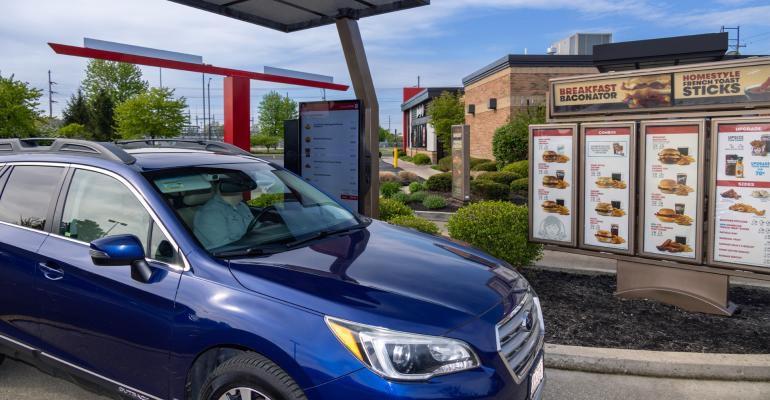Potbelly CEO Bob Wright recently called traffic the “heartbeat of long-term health,” so when industrywide traffic started to dip at the end of last year, red lights started to flash. As it turns out, consumers do have a threshold after two-plus years of higher menu prices in response to historically high inflation.
That said, the narrative about traffic, or visits, has become a bit bifurcated. A new whitepaper from traffic analytics company Placer.ai finds that the quick-service and fast casual segments have experienced year-over-year increases in visits every quarter since Q1 2023, albeit with signs of slowing. Q1 2023 visits in these segments were up by over 7%, for instance, but just 2.1% in Q1 2024.
Conversely, full-service chains experienced a 4.9% increase in visits in Q1 2023, but the category declined in Q2 (-1.5%) and Q3 2023 (-0.8%) before essentially turning flat in Q4 2023 and Q1 2024. Placer.ai suggests that QSRs specifically have benefited from speed of service, pointing to throughput improvements at chains like Taco Bell, Wendy’s, and Chick-fil-A as examples. Nearly 63% of Taco Bell’s visits in 2023 were under 10 minutes, compared to 58.4% in 2019, for example. For Wendy’s, 60.5% of visits were under 10 minutes in 2023, versus 56.4% in 2019, and Chick-fil-A was at 51.9% in 2023 and 48.5% in 2019.
QSRs have invested significantly in recent years to expedite service, including Taco Bell’s Go Mobile design, Chick-fil-A’s digital forward prototype tests, and McDonald’s new to-go-only format near Fort Worth, Texas. Wendy’s also recently expanded its drive-thru AI chatbot test because it was yielding faster service times, according to the company.
Of note, that McDonald’s to-go-only format generated a larger share of shorter visits compared to other McDonald’s locations in the Dallas-Fort Worth region, according to Placer.ai. Over 80% of visits to the location in Q1 2024 were under 10 minutes, compared to 70% market wide. As such, the to-go-only location had nearly 19% more visits than McDonald’s average in the DFW area.
Perhaps it’s no surprise, then, that plenty of full-service concepts are dabbling in speedier formats. Applebee’s opened a to-go and delivery unit on Long Island in September, for example, while several casual dining concepts have added to-go pickup windows and even pickup lockers for digital orders. Placer.ai data shows that the Applebee’s To Go location drew more lunch and weekday visits in Q1 2024 than nearby Applebee’s locations.
Beyond speed
Another factor potentially playing into QSRs’ and fast casuals’ favor is the heavy presence of chicken concepts; in Q1 2024, 15.3% of fast casual and QSR visits were to a chicken-based concept, versus 13.4% in Q1 2029.
This growth is also reflected in new Technomic Ignite data, which found the chicken category overall experienced a double-digital sales increase in 2023 versus 2022. Both Raising Cane’s and Wingstop experienced sales growth of over 20%, for example, while Chick-fil-A’s sales were up nearly 15% year-over-year and have risen by over 43% since 2021.
Indeed, chicken has become the most consumed protein throughout the past 30 years, driven largely by younger consumers who prefer its versatility and perceived health halo. In response to this higher demand, both McDonald’s and Taco Bell are elevating their chicken offerings. Four of McDonald’s 17 $1 billion equities are in chicken and CFO Ian Borden recently said the company needs to have more to be “known for chicken.” Meanwhile, most of Taco Bell’s menu launches this year are also focused on chicken. As Liz Matthews, chief food innovation officer, recently said, Taco Bell’s fans want more chicken.
Placer.ai also suggests that QSRs and fast casuals have effectively leveraged the marketing calendar and limited-time offerings to drive visits. Arby’s fish-focused promotions generated spikes in visits by over 30% during Lent versus daily visit averages, for example. White Castle’s signature Valentine’s Day experience led to a nearly 12% increase in visits compared to daily visit averages.
Whether promotions – and chicken – are enough to sustain higher traffic levels in a stubbornly high inflationary market is yet to be seen. Perhaps a more effective way to get back to those early 2023 visits, however, is to rein in pricing and the industry does seem to be moving in that direction. The Consumer Price Index for March showed that limited-service restaurant prices were up 0.3% during the month, which was lower than the 0.4% increase overall. Still, year-over-year, prices are up by 5% in limited-service restaurants, and 3.2% at full-service restaurants.
Contact Alicia Kelso at [email protected]





